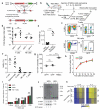Targeted genome editing in human repopulating haematopoietic stem cells
- PMID: 24870228
- PMCID: PMC4082311
- DOI: 10.1038/nature13420
Targeted genome editing in human repopulating haematopoietic stem cells
Abstract
Targeted genome editing by artificial nucleases has brought the goal of site-specific transgene integration and gene correction within the reach of gene therapy. However, its application to long-term repopulating haematopoietic stem cells (HSCs) has remained elusive. Here we show that poor permissiveness to gene transfer and limited proficiency of the homology-directed DNA repair pathway constrain gene targeting in human HSCs. By tailoring delivery platforms and culture conditions we overcame these barriers and provide stringent evidence of targeted integration in human HSCs by long-term multilineage repopulation of transplanted mice. We demonstrate the therapeutic potential of our strategy by targeting a corrective complementary DNA into the IL2RG gene of HSCs from healthy donors and a subject with X-linked severe combined immunodeficiency (SCID-X1). Gene-edited HSCs sustained normal haematopoiesis and gave rise to functional lymphoid cells that possess a selective growth advantage over those carrying disruptive IL2RG mutations. These results open up new avenues for treating SCID-X1 and other diseases.
Figures





Comment in
-
Gene therapy: Repair and replace.Nature. 2014 Jun 12;510(7504):226-7. doi: 10.1038/nature13344. Epub 2014 May 28. Nature. 2014. PMID: 24870243 No abstract available.
References
References of the main text
-
- Cartier N, et al. Hematopoietic stem cell gene therapy with a lentiviral vector in X-linked adrenoleukodystrophy. Science. 2009;326:818–823. - PubMed
-
- Biffi A, et al. Lentiviral Hematopoietic Stem Cell Gene Therapy Benefits Metachromatic Leukodystrophy. Science. 2013;341:1233158. doi:10.1126/science.1233158. - PubMed
Additional References
-
- Miller JC, et al. An improved zinc-finger nuclease architecture for highly specific genome editing. Nat Biotechnol. 2007;25:778–785. - PubMed
-
- Akatsuka Y, Martin EG, Madonik A, Barsoukov AA, Hansen JA. Rapid screening of T-cell receptor (TCR) variable gene usage by multiplex PCR: application for assessment of clonal composition. Tissue Antigens. 1999;53:122–134. - PubMed
-
- Wu CJ, et al. Reconstitution of T-cell receptor repertoire diversity following T-cell depleted allogeneic bone marrow transplantation is related to hematopoietic chimerism. Blood. 2000;95:352–359. - PubMed

